Displaying items by tag: Sean Walsh
Irish President for the Old Gaffers Association
#oga – For the first time in its 50 years, the Old Gaffers Association has an Irish President. W M Nixon profiles Sean Walsh as he begins a three year term heading up this increasingly international organisation, which raised its profile with 2013's Golden Jubilee celebrations including major events for classic and traditional craft in Dublin, Belfast, and Peel in the Isle of Man.
If you were putting together the dream profile of an ideal person to become the first Irish President of the Old Gaffers Association as that somewhat quirky organisation quietly flexes its muscles on completion of the successful celebration of its Golden Jubilee in 2013, then you'd come up with somebody very like Sean Walsh.
In London last Saturday, he was elected to a three-year term as President of the OGA. In its fifty years, the Association has grown from being an informal organisation based around the Thames Estuary and the Solent into an international body with branches throughout the UK and Ireland, in addition to groups in the Netherlands, Belgium, France, British Columbia, Australia and New Zealand. Yet despite this steady and widespread growth, Sean Walsh, the eleventh President, is not only the first incumbent from overseas, but he's the first one from outside the southeastern half of England.
His fascination with gaff rig and classic design based on proven working boat principles, coupled with his warm enjoyment of the fellowship of the sea, would be impressive qualifications in themselves. But this is combined with high technical ability in boats and their equipment, both ancient and modern. And it's allied to a life experience which has given him the outlook and social skills needed to fulfill a role for which there are few textbooks and precedents.
For sure, there have been, and still are, Irish sailing administrators in major international organisations which are central to mainstream sailing. As a nation, we have punched way above our weight in top roles in the global organisation now known as the International Sailing Federation. And Dun Laoghaire's John Bourke gave unstinting service both as Commodore of the Royal Ocean Racing Club from 1994-1996, and as Chairman of the Offshore Racing Council, while the RORC has also seen major input from Cork with the late Denis Doyle as a Flag Officer, a role recently filled by Anthony O'Leary while Dun Laoghaire is currently rising in the officer ranks again with Michael Boyd (RIYC) now serving as RORC Vice Commodore.
But the Old Gaffers Association is different. In fact, being different is what it's all about. In some ways, you could say it's the sailing organisation which provides a home for boat enthusiasts who don't feel comfortable anywhere else. Thus it is very accommodating about including people whose boats might happen to be Bermudan rig, provided they're the right sort of people with the right sort of boats, and a sound attitude to gaff-rigged folk.
And it's an organisation which bends over backwards to extend the hand of friendship to sailors in countries where gaff rig never really was in danger of disappearing, such as The Netherlands and Ireland. The continuance of gaff rig as an accepted part of the scene in these places might have meant that something like the OGA would be regarded as a superfluous layer of organisation, almost an impertinence. But the Association's engaging enthusiasm and modest promotion of its ideals has brought the gaffers of Holland and Ireland aboard in harmony. Thus the OGA now has an Irish President, and doubtless in time his successors will include a Dutch skipper, and perhaps further down the line someone from the Belgian and French memberships.
It's all a long way down the line from the early days, when the OGA emerged from tentative beginnings with a very English tinge. It's a somewhat amorphous body, both in its times and places of origin, and despite its simple objectives of promoting gaff rig and traditional craft. The first whisperings came at a small meeting in Winchester in 1957, attended by people such as Mike Richardson of the famous Elephant Boatyard on the River Hamble, who were concerned by the rapid disappearance of gaff rig. They agreed that a race for gaff rigged boats would be the ideal way to launch an association, and they agreed that it would be called the Old Gaffers Association with a pitchfork as its symbol, the pitchfork being traditionally used in rural England by ancient rustics - old gaffers - to toss hay. Thus it isn't a gaff jaws, as is usually assumed. And it certainly isn't a picklefork, despite being so described by some smartass modern sailors.
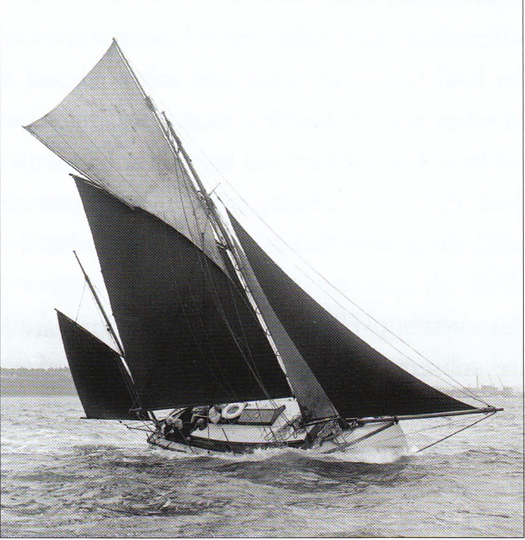
Mike Richardson's Betty racing in the first gaffers' race of 1959, four years before the OGA was formed. Her owner, who ran the famous Elephant Boatyard on the River Hamble, was a man of many sailing interests – he also was a regular offshore competitor with his S&S-designed fiberglass She 31 Arctic Skua. Photo courtesy OGA
Though the name of the Association and its burgee may have emerged fully formed in 1957, little else did. The first race wasn't held until 1959, off the River Hamble, and it became an annual event of sorts. But it was round on England's east coast in the Thames Estuary that the encouragement of the preservation of gaff rig found its most fertile ground, and on Saturday July 20th 1963 the Old Gaffers Race from the Blackwater to Harwich got going with 30 starters, though only seven finished as a forecast sou'wester became a light easterly.
The winner was one of the oldest boats in the fleet, Fanny of Cowes, and the OGA came formally into being. Despite the frustrations of that first East Coast Race, there were 35 starters the following year, when there was also a race for gaff-rigged yachts at the Royal Gourock YC in the Clyde. So there was clearly a grass roots movement of support for gaff rig at a time when plastic boats and alloy Bermudan masts seemed destined to wipe them out. But as many of the gaffers had eccentricity as their default mode, getting them into any cohesive organization was a slow process.
Yet over the years it has gradually developed, building up area associations, and based almost entirely on an enthusiasm for gaff rig and vintage craft which may be shared and displayed by people who do not necessarily have gaff rigged boats themselves, nor indeed vintage craft of any type. In fact, there's a significant segment of the membership made up of sailing folk who don't quite fit into any specific category, and nor do their boats if they have them, but the OGA provides them with a congenial spiritual home.
There has been a Northern Ireland branch since the late 1980s, while a Dublin Bay branch is of similar vintage, and in times past it was notably active when Dublin port and Howth were home to a vibrant flotilla of restored Galway hookers. But of course the revival of the Galway hookers was something which had been happening independently of similar movements elsewhere in Holland and England.
It was in 1974 that the last commercial cargo of turf was sailed out from Connemara to the Aran Islands on a hooker. Yet some of the old boats were kept going for the annual sailing events in the Land of the Sea, particularly the MacDara's Festival on July 16th. Then in 1976 Johnny Healion of Dublin appeared in Connemara with the magnificently-restored Morning Star, and the show was back on the road. I can vividly remember sailing from Clew Bay down to MacDara's Island in 1978 with the late great Tad Minish on his Finisterre yawl Kiff in order to witness the revitalized gathering of the boats and their racing, and the sense of a new spirit of enthusiasm being allied to a tradition half as old as time was palpable.
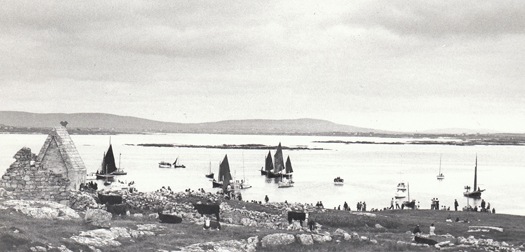
The traditional gathering of the Galway hookers at St MacDara's Island in Connemara, July 16th 1978. It was in 1976 that Johnny Healion had inspired the hooker revival with his restoration of Morning Star. Photo: W M Nixon
Thus the idea of an association simply devoted to venerating gaff rig seemed almost absurd in Connemara – what other sort of rig was there? But with goodwill on all sides, the boats of the west in their alternative times as boats of the east around Dublin Bay brought a huge infusion of sailing vitality to the Dublin Bay OGA, and with now-legendary regattas such as that at Portaferry at the entrance to Strangford, the message was spread.
Ironically, when the OGA itself had come into being in 1963, it was the very year that John Kearney was persuaded to oversee the conversion of the Dublin Bay 21s in Dun Laoghaire from gaff to Bermudan. But the Howth 17s have stayed loyal to gaff – complete with jackyard tops'ls – so as the Golden Jubilee of the OGA approached with the festivities planned for Dublin and Belfast, it seemed an ideal opportunity for the 115-years-old Howth 17s and the 50-years-old Old Gaffers Association to get together for the first time, and one of the people who worked behind the scenes on making this happen was DBOGA Committee Member Sean Walsh.
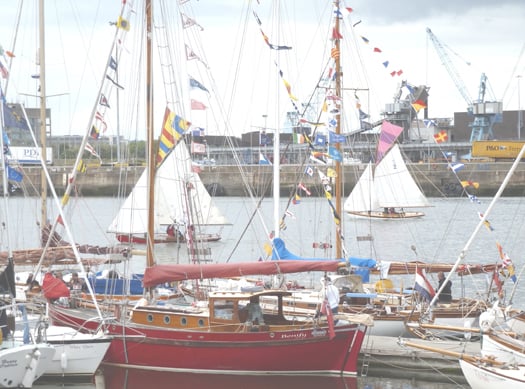
A dream comes true. The Howth 17s arrive in to join the OGA Golden Jubilee celebrations at Poolbeg Y & BC on Saturday June 1st 2013. Although the Howth 17s had been sailing under gaff rig for 115 years, and the OGA had been in being for fifty years, it was the first time the two groups had got together. Photo: W M Nixon
His life-story is a tale for our times. Born in Cork to a family north of the Lee, he was one of eight children, but as siblings appeared on an almost annual basis, he was effectively adopted by his aunt and uncle, who were childless. He cheerfully claims to have been spoilt rotten, but he grew up in a thoughtful household. When we remember that Cork was effectively Ford City in those days, the fact that his uncle drove a Morris Minor tells us much. It tells us even more that, when the little car needed new big-end bearings, his uncle educated young Sean into the ways of engineering and mechanics by having him as helper one Saturday morning while the uncle in his garage at home lifted out the engine, replaced the bearings with Sean to hand him tools and parts as required, and then re-installed the engine, all neatly in time for lunch.
His schooling was with the Christian Brothers at North Mon, where some of the Brothers took it into their heads to acquire an ancient little leaky fishing boat around 25ft long with a seized engine. They made it seaworthy or at least capable of floating, got the engine back to life, and based it at Kilbrittain on Courtmacsherry Harbour for a sort of informal sea training course for those pupils who had helped with the boat's restoration, which naturally included young Sean Walsh.
With his enthusiasm for getting afloat developing rapidly while still at school, having spotted the plans in a DIY magazine for a build-her-yourself 16ft canoe designed by Percy Blandford, he built three of these slim craft through two rooms in his parents' third floor attic. It was a neat building job, an elegant framework skinned by heat-stretching PVC sheet. His successful business plan was to sell two to finance his own ownership of the third. Getting them out of the attic was a hairy business which involved sending a messenger rope over the top of the house to provide a sort of crane, as the boats had to emerge cleanly and horizontally through a window still small despite the removal of its frame. But somehow they were safely lowered to a crowd of helpers far below, and the flotilla was ready to cruise.
And what a cruise they had, starting from the sacred location of Gougane Barra on the headwaters of the River Lee among the mountains away to the west, and spending three weeks descending the valley to Cork using wheels from a cannibalized Silver Cross pram to help them get the canoes through the many portages.
With hessian sacks made only slightly waterproof by a sort of plastic coating to provide a tent, and with eternally damp blankets rather than sleeping bags, it was a hardy life. But they throve on it and fed well with more than a little foraging, reckoning that the farmers owning the riverside potato fields wouldn't begrudge the three hungry young voyagers a feed of liberated spuds each night.
After school, Sean's first fulltime job was on the production line in the Dunlop Tyre plant, a Leeside institution back in the day. But even though with overtime he was soon earning enough to acquire a Triumph Spitfire sportscar, he was restless. In 1960s Cork, the class barriers were harshly drawn. But he yearned for something which provided outlets beyond the skilled manual work which seemed to be his allocation in life. He'd long been interested in radio, electrics and electronics, and the Radio & Electronics Institute in Cork provided a course which could qualify him as a ship's radio officer, so he sold the car to pay for the course.
As for transport, he was able to use his canoe to commute from home down the Lee to the riverside Institute – "I learnt a lot about tides". And in due course he qualified, and then was offered a job, due to start from Liverpool in five weeks time, as a Ships Radio Officer.
He had his new uniform bought and all when his aunt showed him an ad in the paper for electronic technicians up above in Dublin, working for some outfit called IBM. Those who would persuade the Irish to become a seafaring nation one and all should realize that they should be working on the womenfolk and their views on the matter. His aunt was secretly horrified at the thought of her beloved nephew going off to sea. So as he'd the five weeks to put in before he joined his ship, Sean did her the courtesy of applying for an interview, and in those pre-Google days, he went to the local library to learn a bit about IBM.
Anyone who has read the recent Steve Jobs biography will have learnt of the reverence with which IBM is held in the grown-up business community. Back in the 1960s, the company was at the exciting stage of building up its unrivalled reputation. It looked like a stimulating place to work, and young Sean Walsh was so interested by what he'd read about it that he sailed through the interview, within a week he'd been offered a job which in 1969 began his 36 year career with IBM, and the Radio Officer's uniform went into the wardrobe.
But while he may have been working in IBM computers for some of the key companies in Ireland and living in Dublin, if anything his interest in boats increased, and now it encompassed sailing. Having proven his business plan with the success of building three canoes and keeping one for himself, in the front room of his first house (it was in Portmarnock) he built three Fireballs, and after they'd been approved by the class measurer, a young fellow called David Lovegrove, he was able to sell two and keep the third to teach himself to sail on Broadmeadow Water in Malahide, most of which is a safe depth which means you can stand up when you capsize. As he did a lot of capsizing learning to sail a Fireball single-handed, he did a lot of walking around in water up to his chest.
But he learnt to sail too, and got involved with the sailing scene at many levels. Like a lot of men with young sons, he built a Mirror dinghy and did miniature cruises. Then at another stage in life, he was active as an instructor in Glenans. Having been self-taught in sailing, he had much to contribute at the Glenans base on Clew Bay.
However, the more he became involved with boats and sailing, the more he found himself drawn to traditional craft, and gaff rig. Meanwhile his career with IBM was blossoming as the company became world leaders. In a new setup in which, instead of selling products, their philosophy was to provide a total package of solutions, he found himself becoming a project manager. IBM had discovered that with computers, somebody with a technical background talking with genuine enthusiasm about what the machines could do was actually much better at selling to hard-headed executives than the traditional salesman with his shallow patter.
So in this multi-functional role, he went along for a first meeting with the Financial Controller of Readymix Concrete, who'd expressed interest in an IBM system. In preliminary pleasantries, Sean said something about the peculiar weather. The FO agreed, saying it was unusual to get so many sou'easters at that time of the year. So Sean took a conversational flyer:
"What kind of a boat do you have?"
"She's a bit unusual. She's called a Heard 28. She's a gaff-rigged cutter, looks old style but has a fibreglass hull. She's a super boat."
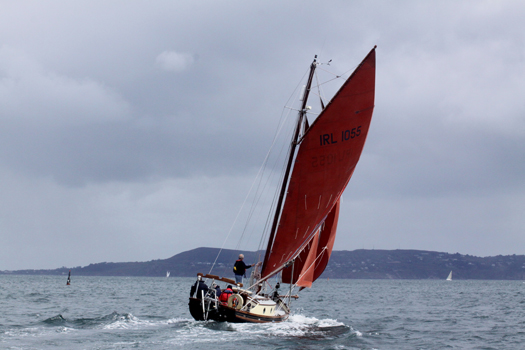
Storming along. Tir na nOg is a Heard 28, designed by Percy Dalton and based on the Falmouth Working Boats which are legally required to dredge for oysters under sail only. The Heard 28 is one of the most successful of the "plastic gaffers" which now form a significant part of the fleet of the OGA. Photo: Dave Owens
Thus did Sean Walsh meet Gerry McEvoy, owner of the Tir na nOg of Howth. They talked boats for a solid two hours, then - the working day being long over - agreed within five minutes the outline of the system IBM would provide for Readymix. And then, once the system Sean designed was installed and working satifactorily, he accepted an invitation to go sailing on Tir na nOg, and now, 22 years later, has been sailing on her ever since.
Sadly, after a number of years of being shipmates together, Gerry was to die cruelly young. But in partnership with another sailing friend, Gerry Murtagh, Sean bought Tir na nOg himself. It was in 2003 that they sailed into Howth Harbour and were invited into an assembly of gaff rigged boats convivially gathered at Howth Boat Club at a Dublin Bay Old Gaffers Association event. As the evening went merrily long, a sister-ship of Tir na nOg's came into port and joined the party. It was Englishman Mike Shaw and his son, cruising round Ireland with the Susan J.
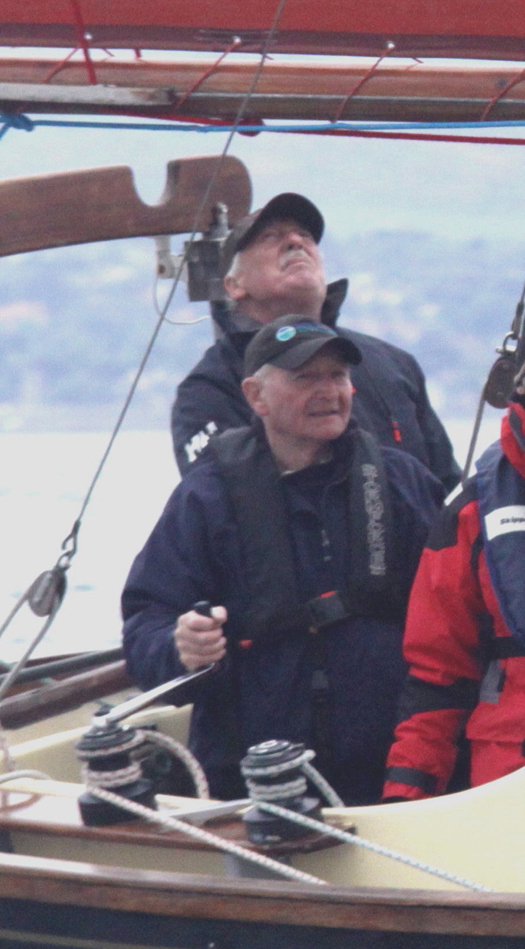
The top men. Mike Shaw (foreground) crewing for Sean Walsh (on helm) aboard Tir na nOg during the race for the OGA's Leinster Plate in Dublin Bay Photo: Dave Owens
Mike was a longtime Old Gaffers Association stalwart, so Sean Walsh found himself getting the OGA message both at local and central levels in a big way. He embraced the concepts of the organization with such enthusiasm that, in the eleven years since that fortuitous meeting in Howth, he has served on the Committee of the Dublin Bay OGA, and as its Honorary Secretary and DBOGA President. And he has also been on liaison duties with headquarters where his friend Mike Shaw was being quietly positioned in order to be President when the Golden Jubilee came around in 2013. Thus when the OGA Golden Jubilee Round Britain fleet came west to Ireland in June 2013 for major events in Dublin and Belfast, Sean had the satisfaction of seeing his hopes of the Dublin fleet, well supported by the Howth 17s, make the Riverfest in the Liffey and the two special races in Dublin Bay into one of the outstanding events of the entire Golden Jubilee.
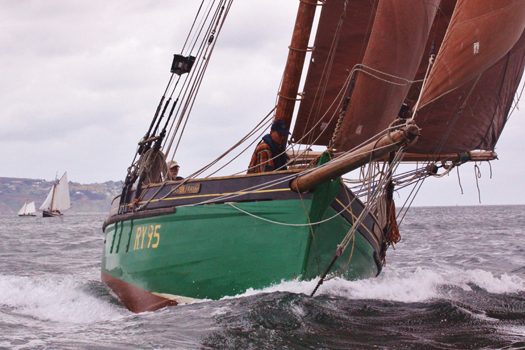
The OGA's fellowship of the sea. Noted Irish explorer and traditional boat sailor Paddy Barry is just visible at the helm of Joe Pennington's 1895-built Manx longliner Master Frank as they prepare to start in the race for the Leinster Plate in Dublin Bay. Photo: Dave Owen
After such a year, the following season might threaten to be a bit of a downer for the OGA, but the new President doesn't see it that way. Though he turns 70 this year, Sean Walsh is full of beans, and while he may have retired from his long and successful career at IBM, he's not he retiring type. From the work point of view, he keeps himself busy as the Yanmar Marine Engines agent for Ireland's east coast, for there's no way he's going to let all that engineering talent and experience go to waste.
And as for the continuing development of the OGA, he's fairly bubbling with ideas. His own lifetime experience is invaluable in helping the Association develop its concepts about the best ways of introducing young people to sailing and traditional boats, and keeping them interested. As for his unrivalled experience in computers, that too is of unique value for an association which, while specializing in traditional craft, relies increasingly on the latest technology to spread its messages and keep its boats and people records up-to-date.
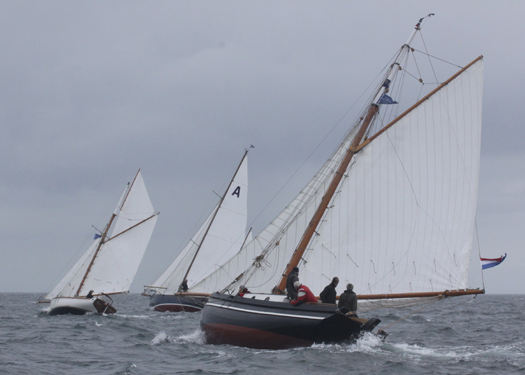
Dutch sandwich. Ainmara (Dickie Gomes, Strangford Lough) seen between Raven (left) Fred Schottman, Makkum, Holland, and Cine Mara (Rik Janssen, Makkum) shortly after the start of the race for the Leinster Plate in Dublin Bay. The Dutch boats made up the largest contingent which went right round Britain for the OGA Golden Jubilee, and in 2014 they will be celebrating the tenth anniversary of their own branch of the OGA with a cruise-in-company in The Netherlands. Raven is a Lyle Hess 28 while Cine Mara is steel built based on the classic Galway hooker design. Photo: Dave Owens
As for life afloat, while 2013 was the Golden Jubilee of the central association, 2014 is the Tenth Anniversary of the lively Dutch branch. The Dutch boats were among the stars when the OGA came to Dublin last June, and their planned cruise-in-company for all interested OGA members through the incomparable waters of the Netherlands in July this year is expected to be the highlight of the season.
So when I met the new President shortly after his return from London this week and considered the demands on his time with the many active local branches, the up-dating of central administrative systems, and the special demands of the Dutch celebrations, I could only suggest that he was going to need a fulltime Personal Assistant.
"I have one already" said Sean Walsh, "I meet him first thing every morning when I look in the mirror".
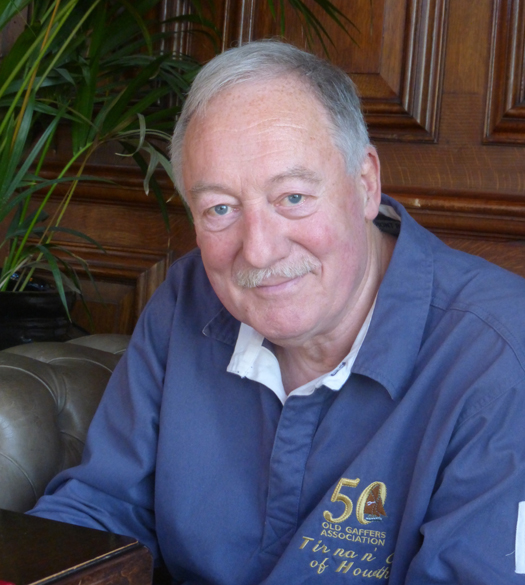
Sean Walsh, eleventh President of the Old Gaffers Association. Photo: W M Nixon
The Dublin Bay Old Gaffers Association (DBOG) Winter /Spring lecture programme continues in the Poolbeg Yacht Boat Club & Marina (PYBC). with the next lecture: "The Installation, Operation and Maintenance of Marine Diesels". The lecture will be held on Tuesday, February 8th and the presenter is Sean Walsh (Yanmar Agent).
For further information on the DBOG lectures please contact Tim Magennis on 087 2593113. For information in general about the PYBC Tel: (01) 668 9983 or logon to www.poolbegmarina.ie/


































































